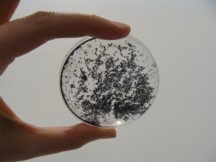Home > Press > Peratech creates fast-acting Electronic Nose using QTC technology
 |
| Granular QTC used in Peratech's nose |
Abstract:
Peratech, the innovator in touch technology, is developing an Electronic Nose using its award-winning, Quantum Tunnelling Composite material. This new sensor technology detects the presence of Volatile Organic Compounds (VOCs) very rapidly and can recover equally quickly, in a matter of seconds.
Peratech creates fast-acting Electronic Nose using QTC technology
Richmond, UK | Posted on May 11th, 2012QTC™ materials change their resistance when a force is applied and, in this case, the polymer content of the composite swells when exposed to VOCs. One form of Peratech's sensor uses a granular type of QTC material that provides a high surface area for absorption enabling it to detect levels of VOCs in the region of 10-100 ppm. The sensor rapidly recovers once the VOCs have gone from the surrounding atmosphere and it is the speed of sensing and recovery that marks the difference between QTC sensors and those using other sensing technologies. An additional feature of the QTC technology is that it has very low power requirements.
"The electronic nose application was developed in conjunction with the Quantum Tunnelling Composite research group at the University of Durham," explained David Lussey, CTO of Peratech. "We are now looking for companies who are interested in licensing the technology from us to develop products."
Professor David Bloor, who is involved in a long-term collaboration with Peratech, added, "Quantum Tunnelling Composite is unique in the area of materials science and a team of researchers and students have been involved in the investigation of its properties. These never cease to amaze and open up different ways in which it can be used."
The conductive particles used in the QTC Electronic Nose have nano-sized features and are distributed in a non-conductive polymer. When a force is applied or swelling occurs, the particles move close enough for the electron flow between the particles to alter due to an effect called Quantum Tunnelling. The polymer used is selected for its response to the particular VOCs to be monitored.
####
About Peratech Limited
Peratech is the inventor of Quantum Tunnelling Composite technology. QTC materials are re-inventing the Human Machine Interface with Touch Innovation™ that improves, extends and enhances the user experience - making possible solutions that could not be made before. QTC materials give enormous flexibility in the design, shape, thickness and style of a switch or touch sensor and can be made in a range of forms from traditional switch replacements, through textile and screen printed switches to innovative, pressure-sensitive QTC Touchscreens that allow for three dimensions of input. QTC solutions are thinner, smaller, more discrete, less expensive and ultra-reliable as there are no moving parts. A Touch Amazing™.
For more information, please click here
Contacts:
Peratech Limited
Old Repeater Station
Brompton-on-Swale, North Yorkshire, DL10 7JH United Kingdom
Tel: +44 (0) 8700 727272
Fax: +44 (0) 8700 727273
Nigel Robson
Vortex PR
Island House, Forest Road
Forest, Guernsey, GY8 0AB United Kingdom
Tel: +44 (0) 1481 233080
Copyright © Peratech Limited
If you have a comment, please Contact us.Issuers of news releases, not 7th Wave, Inc. or Nanotechnology Now, are solely responsible for the accuracy of the content.
| Related News Press |
News and information
![]() Simulating magnetization in a Heisenberg quantum spin chain April 5th, 2024
Simulating magnetization in a Heisenberg quantum spin chain April 5th, 2024
![]() NRL charters Navy’s quantum inertial navigation path to reduce drift April 5th, 2024
NRL charters Navy’s quantum inertial navigation path to reduce drift April 5th, 2024
![]() Discovery points path to flash-like memory for storing qubits: Rice find could hasten development of nonvolatile quantum memory April 5th, 2024
Discovery points path to flash-like memory for storing qubits: Rice find could hasten development of nonvolatile quantum memory April 5th, 2024
Sensors
Announcements
![]() NRL charters Navy’s quantum inertial navigation path to reduce drift April 5th, 2024
NRL charters Navy’s quantum inertial navigation path to reduce drift April 5th, 2024
![]() Discovery points path to flash-like memory for storing qubits: Rice find could hasten development of nonvolatile quantum memory April 5th, 2024
Discovery points path to flash-like memory for storing qubits: Rice find could hasten development of nonvolatile quantum memory April 5th, 2024
Quantum nanoscience
![]() Simulating magnetization in a Heisenberg quantum spin chain April 5th, 2024
Simulating magnetization in a Heisenberg quantum spin chain April 5th, 2024
![]() Optically trapped quantum droplets of light can bind together to form macroscopic complexes March 8th, 2024
Optically trapped quantum droplets of light can bind together to form macroscopic complexes March 8th, 2024
![]() Bridging light and electrons January 12th, 2024
Bridging light and electrons January 12th, 2024
![]() 'Sudden death' of quantum fluctuations defies current theories of superconductivity: Study challenges the conventional wisdom of superconducting quantum transitions January 12th, 2024
'Sudden death' of quantum fluctuations defies current theories of superconductivity: Study challenges the conventional wisdom of superconducting quantum transitions January 12th, 2024
|
|
||
|
|
||
| The latest news from around the world, FREE | ||
|
|
||
|
|
||
| Premium Products | ||
|
|
||
|
Only the news you want to read!
Learn More |
||
|
|
||
|
Full-service, expert consulting
Learn More |
||
|
|
||








